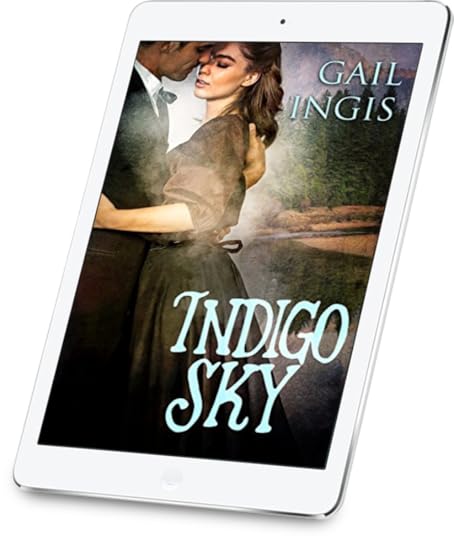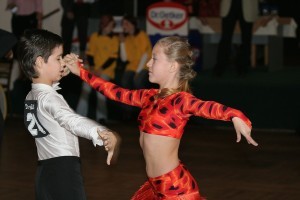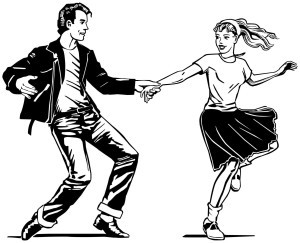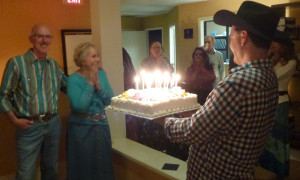Gail Ingis's Blog, page 14
June 15, 2017
BEAUTY IN A BOTTLE

Gail Ingis (I’m using Beautycounter products)
Beauty in a bottle has been around 6000 years. From the copper and lead ore that the ancient Egyptians used to create the world’s first cosmetics to the scientifically advanced products of today that can do everything from hide pores, smooth complexions, and turn the pale green of your eyes a vivid shade of emerald, makeup has been an integral part of humankind for thousands of years. Over the centuries, women used burnt matches to darken their eyes, berries to stain their lips and young boys’ urine to fade their freckles. They even swallowed ox blood in some misguided attempt to improve their complexions.
Women throughout history put their health at risk with many of their homemade cosmetics. In some cultures, for example, women used arsenic, lead, mercury, and even leeches to give themselves the pale appearance deemed beautiful in the old days. Thankfully, we’ve come a long way from the days of using toxic and deadly mixtures to enhance our looks. Or have we?
According to the Scientific American Magazine, the government knows just about as much as you do about what you’re putting on your skin—that is to say, not much. My recent encounter with Beautycounter has answered the many questions I have had about women’s health and allergies that have become prevalent over the last thirty or forty years. Has women’s health been affected by what they use for their face and bodies? BeautyCounter’s Gregg Renfrew has answers:

Gregg Renfrew, Founder of Beautycounter
Like many of you, I’m a wife and mom—and, like many of you, I didn’t know what I didn’t know. As I applied sunscreen, lotion, and any number of beauty products on myself and my kids, I never thought for a second they might not be safe: After all, I thought, we live in a country that regulates everything. So imagine my surprise when I learned that when it comes to the personal care industry, that’s simply not the case. Companies are allowed to use harmful ingredients and make their own judgments about safety. And so I started Beautycounter, a company devoted to progress. Here you’ll find a wealth of empowering information about ways we can all make the world healthier, along with safer products you can trust. Because we all deserve better. Our vision is bold; real answers are never timid. Help us put truth back in beauty. 
Our Mission To get safer products into the hands of everyone. Decades of studies indicate that serious health issues (including but not limited to asthma, cancer, and infertility) are on the rise and are due in some part to our ongoing exposure to toxic chemicals—whether it’s in the shower, on our commute, while we eat lunch at a local restaurant, or when we clean our kitchens at home.
There are more than 80,000 chemicals on the market today. Many don’t have any safety data. This is particularly true of those used in the skin care and beauty industry. What’s worse is that the Food and Drug Administration (the agency that regulates cosmetics in the United States) allows companies to use chemicals known to be extremely harmful in the products we put on our bodies and on our kids’ bodies every single day, day after day, and to make their own judgments about safety. It’s time for a change.
The United States has not passed a major federal law to regulate the safety of ingredients used in personal care products since 1938. Over the past two decades, the European Union has banned more than 1,300 chemicals in the product formulas of personal care products and restricted the levels of over 250 more in such products. The United States has only partially banned 30 to date.
We deserve better, and we’re doing something about it. At Beautycounter, we’re committed to a health and safety standard that goes well beyond what’s required by U.S. law: We’ve banned the use of more than 1,500 questionable or harmful chemicals through our “Never List”—all while ensuring our products perform and that they’re as indulgent as any other shampoo, lipstick, or oil in the market. It’s not easy work, but it’s well worth it. This is about progress—not perfection. Because every little bit counts.
Learn more about the impact the environment is having on your health.
www.beautycounter.com/ourstory
The prestigious and reliable Scientific American Magazine speaks: https://www.scientificamerican.com/article/how-safe-are-cosmetics/
Finding Beautycounter has been fantastic for me. I asked a friend what she was doing these days, she told me she found this company that was doing amazing work like developing safe products for face and body. According to the FDA, an average U.S. consumer uses about 10 cosmetic products in a day, including makeup, soap, shampoo, lotion, hair gel and cologne. Join me in treating your body well with Beautycounter products. I love their makeups and creams and feel safe using them.
Check out www.beautycounter.com to see what’s available.
Let me know if you want to sample any: http://beautycounter.com/gailingis. According to the FDA, a cosmetic is anything used for “cleansing, beautifying, promoting attractiveness or altering the appearance.
June is Audiobook Month! Try out Whispersync with INDIGO SKY. Audible: http://adbl.co/2tjUzyY … Amazon: http://amzn.to/2qGIL8v
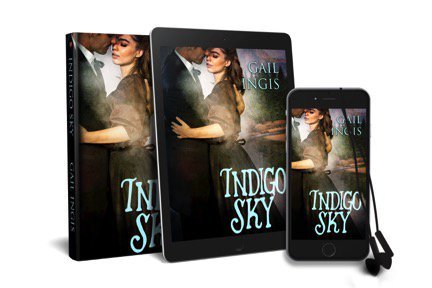
June 7, 2017
GUEST AUTHOR SAMANTHYA WYATT

Teaser Tuesday banner
Welcome. Yes, you are at Gail Ingis’s blog. I invited my friend and colleague, Samanthya Wyatt, to post her Teaser Event to share with my readers. Feel free to visit her website to sign up to win book(s) from many different authors who she has sponsored over the last three years. I was fortunate to have been one of the visiting authors and be included in this event. You will find my book, Indigo Sky, on the list.
A teaser from the newsletter June 2017

Samanthya Wyatt
Welcome to Teaser Tuesday! Where we can get a snippet of a story that arouses the reader — hints at mystification — a quickening that stirs the blood. Once I decided to create a newsletter, I had to give it a name. Teaser Tuesday sounded great for guest authors revealing a paragraph or two of their book.Then I thought I’d like to feature other items as well. Like: What’s happening in the world today? Are you an author — or do you just like to read? What’s going on in your life? Seasonal changes —workshops — contests – pitch opportunities.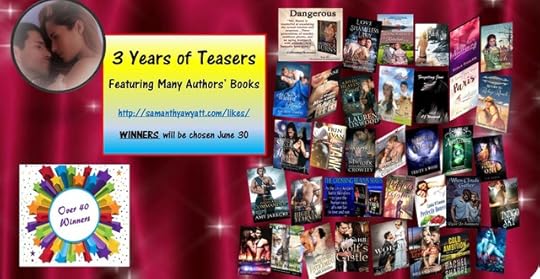
On the first Tuesday of each month, my hope was to generate, prompt, motivate — all the things to inspire authors. And I thought it would be great to feature a guest. I ended up with at least three each month, posting a morsel of each guest author’s book. Don’t you just love it when you get a tidbit? You read faster, your heart races, and all of a sudden … cliffhanger.These authors, writing many different genres, are helping me celebrate by giving away copies of their books to romance readers.
TO FIND OUT MORE – Visit my web page and sign up to be entered for free books: http://samanthyawyatt.com/likes/

Indigo Sky for reader who enjoy historical romance! @AmazonKindle http://amzn.to/2nWqbcq Indigo Sky available on Amazon buy link: http://amzn.to/2j0LXLE
Author page: http://amzn.to/1K4GVQA
May 31, 2017
WRITE WITH DESIGN IN MIND

Whitespace . . . Is this about silhouettes or goblet?
Whitespace is a fundamental building block of good design. It’s the first design aspect that any visual designer is taught. What is whitespace? Let me say that it’s not always white. This space may be a color or texture. For authors, white space is the space between blocks of text. Author reviews often mention that the book had lots of white space and they loved that, it gives the reader an enjoyable journey through the story. In this post I explain why whitespace matters.
Design, a critically important element authors often overlook. Words on the page need balance, structure and white space. Maria Connor, Published Author and Author Assistant
Improved legibility
The most obvious benefit of whitespace is that it increases legibility. You only need to compare the examples shown in Mark Boulton’s superb article on whitespace to see how a good use of whitespace can make an enormous difference to legibility.

Before – without whitespace

After – with whitespace
Higher comprehension
Believe it or not whitespace between paragraphs and around blocks of text actually helps people better understand what they are reading. According to research in 2004, this kind of whitespace increases comprehension by almost 20%.

Architecture with negative space, fresh and open
Creates the right tone
Finally the use of whitespace can be a powerful way to communicate elegance, openness and freshness. Obviously this isn’t always the design look and feel you wish to communicate. However when it is, you can’t do better than having loads of whitespace.
For the visual arts, the phrase refers to negative space. In my work, I have found the old adage, “Less is more,” to be true. A phrase used by architect Ludwig Mies van der Rohe in 1947 as a precept for Minimalist design and architecture. The phrase has been used in other applications by the design community over the years. I use it in designing and painting all the time. It is part of my philosophy. The negative is as important as the positive.
Extra Whitespace Information: Did you know that your business card should have at least one whitespace the size of a quarter?And the backside should have a flat finish so the recipient can write who, where and when.
Not everyone thinks whitespace is important. As the volume of content on the web grows, how do you stand out from the noise? Website owners find whitespace to be a waste, they fill every open spot on the page. Websites have become a way to market and promote product with lots of noise. Website owners demand that every space say something. I never know where to look and cannot find anything on those busy websites.

Starbucks clever use of good graphic design with lots of whitespace
Thanks to Paul Boag, click whitespace to see his blog and be sure to click Mark Boulton’s article on whitespace.

Do you give whitespace a thumbs up?
How about you? What do you think about whitespace?

Indigo Sky for reader who enjoy historical romance! @AmazonKindle http://amzn.to/2nWqbcq Indigo Sky available on Amazon buy link: http://amzn.to/2j0LXLE
Author page: http://amzn.to/1K4GVQA
May 24, 2017
IS IT DRAPES OR DRAPERIES?
WRITE DESIGN by Gail Ingis, ASID*

Nope, it’s not working. How do I do this writing thing?
Writing takes more than putting words on paper. Like broadly-scoped art, there are applicable concepts. Writing is creative, right? Creativity and art are parallel, and in all art, there are similarities. Which tools do you use, blank sheet of paper versus blank canvas, keyboard versus sketching pencil, paint brush, camera . . .
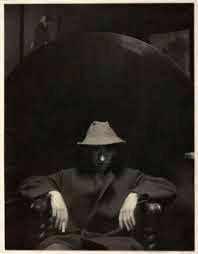
Alfred Stieglitz
Each week my blog will utilize those concepts, like in the books of Dixon and Bickham in their writing or Georgia O’Keefe or Albert Stieglitz or John Singer Sargent in their art. For me, having been degreed and experienced in several arts, such as interior design, architecture, painting, photography, dance, criticism, like the writing of Goldberger or Muschamp, the concepts are similar. Concepts that will impact descriptions in your books.
Today I’m writing about the word “Drape.”
Is it Drapes or Draperies?
 I have a bone of contention with the English-speaking world. Drapes is a verb, Draperies is a noun. I’ll explain. I learned the use of the word, drape/draperies at the New York School of Interior design BFA program. I bet you’re thinking it’s jargon. No. It’s grammar.
I have a bone of contention with the English-speaking world. Drapes is a verb, Draperies is a noun. I’ll explain. I learned the use of the word, drape/draperies at the New York School of Interior design BFA program. I bet you’re thinking it’s jargon. No. It’s grammar.
Me being curious about everything, I checked online to see if this issue had ever been addressed. Low and behold, I found a blog by Mark Scott Drapery Design from December 2009, in total agreement with me, so this blob is a reblog. It’s obvious that Mark understands English grammar, and he most likely has worked with NYSID* interior designers. Thanks Mark Scott!
Needless to say that I was delighted to find someone in this world, other than my design colleagues, that understand the use of the words. No more confusion.
Mark Scott’s reblog: Whenever asked this question I unequivocally respond, “Most definitely, Draperies.” You see, drape is a verb. To drape. As in, He draped his coat over the chair and looked menacingly into her eyes, as if to say, ‘Don’t even think about calling those beautiful window treatments drapes!’ Or, She draped her shawl over her shoulder, rolled her eyes while lighting a cigarette, and loudly asked, in an accusatory voice, ‘Where the hell did you get those god-awful drapes?’
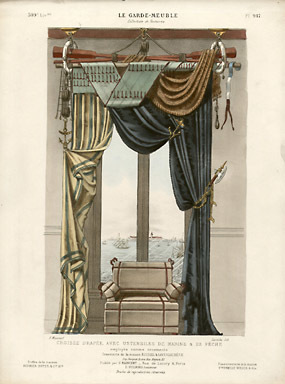
Traditional Draperies 19th Century Greek Revival
Now, if you sell window treatments for a living, as I do, keep in mind that people do not want to pay good money for a verb. Verbs are fleeting. Always in motion and seldom ready to stand alone. They need a subject or object to lean on. People want something self-reliant, long-lasting – something that’s gonna stick around for a while – like a noun. It’s stationary, fixed, not goin’ anywhere and proud of it.
I prefer terminology that suggests longevity and permanence (and that will increase my income potential, of course). Let vagabonds and Philistines have their drapes. Give me my draperies, sir, or prepare to be publicly draped in insult and shame!
So Mark, maybe now our public will refuse to be shamed because they know how to use the verb drape and the noun draperies. Of course you can save yourself anguish if you say ‘curtain.’ But those are usually shorties that shrink your window, Oops did I say something naughty? Next week, we can talk about the difference between floor-to-ceiling draperies and short curtains covering the window only. Tricks to fool the eye, spoken from a pro. Now we are talking about writing descriptions in your book(s).

Thumbs up Mark!
Mark, may I give you a thumbs up for your skill with draperies? https://www.draperyguru.com/
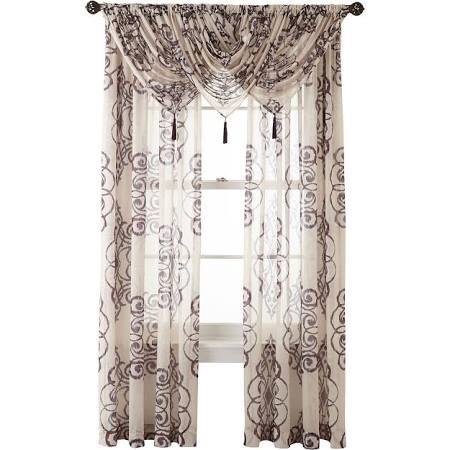
Sheer Curtain Panels, Contemporary design with a draped valance gives these draperies a traditional flare.
*American Society of Interior Designers
*New York School of Interior Design

Indigo Sky for reader who enjoy historical romance! @AmazonKindle http://amzn.to/2nWqbcq Indigo Sky available on Amazon buy link: http://amzn.to/2j0LXLE
Author page: http://amzn.to/1K4GVQA
Is it Drapes or Draperies?
WRITE DESIGN by Gail Ingis, ASID*

Nope, it’s not working. How do I do this writing thing?
Writing takes more than putting words on paper. Like broadly-scoped art, there are applicable concepts. Writing is creative, right? Creativity and art are parallel, and in all art, there are similarities. Which tools do you use, blank sheet of paper versus blank canvas, keyboard versus sketching pencil, paint brush, camera . . .

Albert Stieglitz
Each week my blog will utilize those concepts, like in the books of Dixon and Bickham in their writing or Georgia O’Keefe or Albert Stieglitz or John Singer Sargent in their art. For me, having been degreed and experienced in several arts, such as interior design, architecture, painting, photography, dance, criticism, like the writing of Goldberger or Muschamp, the concepts are similar. Concepts that will impact descriptions in your books.
Today I’m writing about the word “Drape.”
Is it Drapes or Draperies?
 I have a bone of contention with the English-speaking world. Drapes is a verb, Draperies is a noun. I’ll explain. I learned the use of the word, drape/draperies at the New York School of Interior design BFA program. I bet you’re thinking it’s jargon. No. It’s grammar.
I have a bone of contention with the English-speaking world. Drapes is a verb, Draperies is a noun. I’ll explain. I learned the use of the word, drape/draperies at the New York School of Interior design BFA program. I bet you’re thinking it’s jargon. No. It’s grammar.
Me being curious about everything, I checked online to see if this issue had ever been addressed. Low and behold, I found a blog by Mark Scott Drapery Design from December 2009, in total agreement with me, so this blob is a reblog. It’s obvious that Mark understands English grammar, and he most likely has worked with NYSID* interior designers. Thanks Mark Scott!
Needless to say that I was delighted to find someone in this world, other than my design colleagues, that understand the use of the words. No more confusion.
Mark Scott’s reblog: Whenever asked this question I unequivocally respond, “Most definitely, Draperies.” You see, drape is a verb. To drape. As in, He draped his coat over the chair and looked menacingly into her eyes, as if to say, ‘Don’t even think about calling those beautiful window treatments drapes!’ Or, She draped her shawl over her shoulder, rolled her eyes while lighting a cigarette, and loudly asked, in an accusatory voice, ‘Where the hell did you get those god-awful drapes?’

Traditional Draperies 19th Century Greek Revival
Now, if you sell window treatments for a living, as I do, keep in mind that people do not want to pay good money for a verb. Verbs are fleeting. Always in motion and seldom ready to stand alone. They need a subject or object to lean on. People want something self-reliant, long-lasting – something that’s gonna stick around for a while – like a noun. It’s stationary, fixed, not goin’ anywhere and proud of it.
I prefer terminology that suggests longevity and permanence (and that will increase my income potential, of course). Let vagabonds and Philistines have their drapes. Give me my draperies, sir, or prepare to be publicly draped in insult and shame!
So Mark, maybe now our public will refuse to be shamed because they know how to use the verb drape and the noun draperies. Of course you can save yourself anguish if you say ‘curtain.’ But those are usually shorties that shrink your window, Oops did I say something naughty? Next week, we can talk about the difference between floor-to-ceiling draperies and short curtains covering the window only. Tricks to fool the eye, spoken from a pro. Now we are talking about writing descriptions in your book(s).

Thumbs up Mark!
Mark, may I give you a thumbs up for your skill with draperies? https://www.draperyguru.com/

Sheer Curtain Panels, Contemporary design with a draped valance gives these draperies a traditional flare.
*American Society of Interior Designers
*New York School of Interior Design

Indigo Sky for reader who enjoy historical romance! @AmazonKindle http://amzn.to/2nWqbcq Indigo Sky available on Amazon buy link: http://amzn.to/2j0LXLE
Author page: http://amzn.to/1K4GVQA
May 17, 2017
23SKIDOO: FLAT IRON BUILDING

Flatiron Building
Twenty-three skidoo was a happening at a triangular site where Broadway and Fifth Avenue meet. The juxtaposition of the streets and a nearby park caused a wind-tunnel effect. In the early twentieth century, men would hang out on the corner of Twenty-third Street and watch the wind blowing women’s dresses up, so that they could catch a little bit of ankle. This entered into popular culture and there are hundreds of postcards and illustrations of women with their dresses blowing up in front of the Flatiron Building. And it supposedly is where the slang expression “23 skidoo” comes from because the police would come and give the voyeurs the 23 skidoo to get them out of the area.
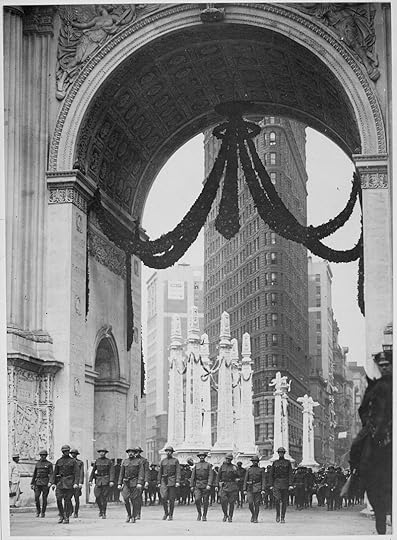
After the end of World War I, the 165th Infantry Regiment passes through the Victory Arch in Madison Square, with the Flatiron Building in the background (1919).
The now familiar distinctive triangular shape of the Flatiron Building, designed by Chicago architect Daniel Burnham and built in 1902, fills the wedge-shaped property. The 22-story iconic office building has been one of New York City’s most dramatic enduring symbols of the city since its birth. It was designated a New York City Landmark in 1966 and was added to the National Register of Historic Places in 1979, and designated a National Historic Landmark in 1989. It is popular with photographers, artists and illustrators.
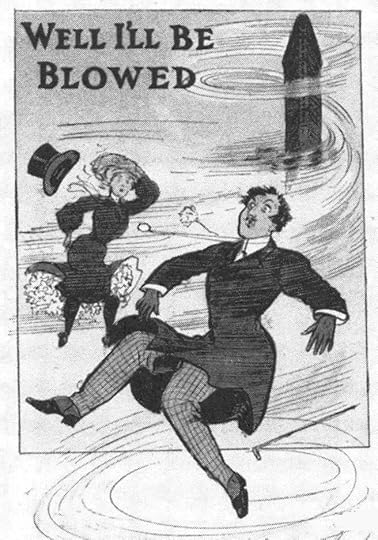
Wind tunnel

The gold dome of the Sohmer Piano Building (1897) is a distinctive landmark of the Flatiron District
The neighborhood around it is called the Flatiron District . The designation is of relatively recent vintage, dating from around 1985, and came about because of its increasingly residential character and the influx of many restaurants into the area. Before that, the area was commercial, with numerous small clothing and toy manufacturers, and was sometimes called the Toy District. Later, the toy businesses moved outside the U.S. and then the area began to be referred to as the Photo District—because of the large number of photographers’ studios and associated businesses located there, the photographers having come because of the relatively cheap rents.
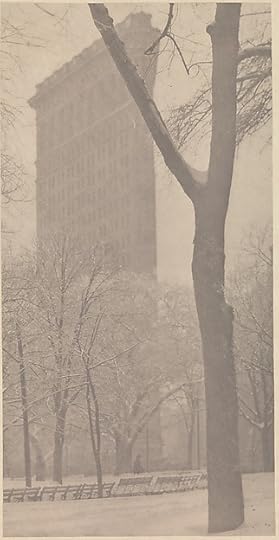
Steilitz Flatiron in winter
Popular photographers like Stieglitz and Steichen photographed the building, along with artists and illustrators who all took the Flatiron as the subject of their work.
As of the 2000’s, many publishers have their offices in the district, as well as advertising agencies. The number of computer- and web-related start up companies in the area caused it to be considered part of “Silicon Alley” or “Multimedia Gulch”, along with TriBeCa and SoHo, although this usage declined considerably after the dot.com bubble burst.
Today, the Flatiron Building is frequently used on television commercials and documentaries as an easily recognizable symbol of the city, and in scenes of New York City that are shown during scene transitions in TV sitcoms and other shows and publications.
What is your favorite place in NYC? Have you visited the Flatiron District? Quite interesting with its museums, restaurants and shoppes.
I need your help! Indigo Sky is up this week in Author Shout’s Cover War. You can vote daily. Any votes would be most appreciated! Just click HERE to vote!
INDIGO SKY
A historical romanceIn a whirlwind romance, a lovely New York socialite marries a fêted, debonair author. But beneath the charm is a cheating husband addicted to hasheesh. Her dream marriage turns sour and the simplicity of her life runs amok when a handsome stranger, her husband’s business partner, threatens her staunch loyalty to her wayward husband.
When she faces the ugly truth about her marriage, her need to finalize her divorce sends her on mad chase across the wilds of nineteenth century America with a handsome stranger where she learns the hard lessons of murder, kidnapping, and more, that almost destroy her.
Amazon | Audible | iTunes
May 10, 2017
GILDED AGE

The Kiss (Lovers), oil and gold leaf on canvas, 1907–1908 Gustav Klimt (popular for its gilt)
The Gilded Age, circa 1870-1900, was a period of rapid economic and social growth characterized by the emergence of a wealthy middle class, excess and embellishment in architecture, art and fashion, fueled by mechanization, transportation, major inventions and the growth of cities. Under the surface however lay significant social tensions- corruption in politics, collusion in business and poverty among unskilled industrial workers, child labor and discrimination.The term “Gilded Age” comes from the satirical novel co-authored by Mark Twain and Charles Dudley Warner and published in 1873 (the process of gilding, applied a thin veneer of gold to a baser material such as pewter or tin to make the artifact appear more valuable, had recently been introduced). Twain likened it to an era of serious social problems masked by thin gold gilding.
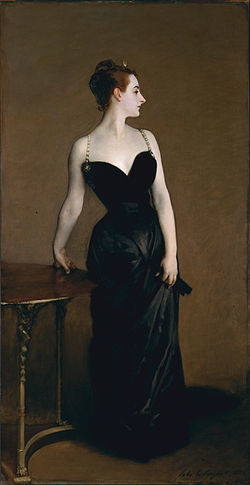
Madame X 1894 John Singer Sargent
For the purposes of this blog, I chose to point out the visual arts of the era when American painters emerged: Mary Cassatt, Winslow Homer, John Singer Sergeant, Childe Hassam and others. Art of the romanticized West by Albert Bierstadt, Charles Remington et al.
Are we in a new Gilded Age? Which artists, in any creative field, will become associated with this era?

Washington Square, NY Childe Hassam, 1895
May 3, 2017
AUTHOR ASSISTANT: AN INSIDE LOOK

Maria Connor
Maria and I found each other at RWA 2014 Atlanta. We met over an iPod Nano. We never talked about writing, only music on her tiny Nano. The tiny toy and its 5000 songs fascinated me. She gave it to me. I’ll have it with me at Disney RWA this year. If you catch me, I’ll show you. It has all my songs now. Imagine?
One day late last year, I noticed “Maria Connor, Author Assistant” in an RWA email. I called to ask if she was the same Maria that gave me the Nano. “Yes,” she said. I asked if she could help me with my work. She was booked, but offered a consult. The consult was terrific. Then early this year, I received an email asking if I was still interested in her services. I immediately said yes, and it’s been fantastic—we work well together.
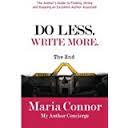
Maria’s book, easy read: DO LESS, WRITE MORE buy link:http://amzn.to/2pYh7ri
I asked Maria if she would explain what an Author Assistant does, and how to find one because it’s wonderful.
Here’s Maria: The Author Assistant offers one of the most in-demand support services. Here are suggestions and insights about how assistants work in today’s publishing environment.
What is an Author Assistant?
An Author Assistant, aka virtual assistant or personal assistant, provides support services to writers. They are usually freelance or contract positions. Some assistants work with a single author while others support several authors. Many work remotely, but some work with their clients in person.
What Does an Author Assistant Do?
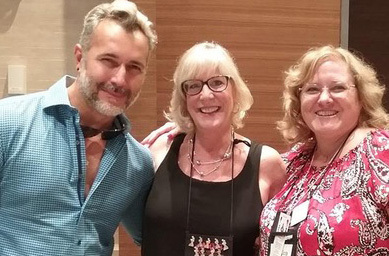
left to right: Reader/fan at RWA BookSigning 2016 with Roxanne St. Claire and Maria Connor
There is no standard job description yet for the Author Assistant because needs of the author differ. Here’s a partial list of services offered by most assistants:
Entering contests and sending prizes to winners
Formatting books
Coordinating events (eg, Book signings)
Social Media management
Designing and formatting newsletters
Updating/maintaining websites
Working with reader teams
Creating teasers and graphics
Marketing support and assistance
How Can Hiring an Assistant Benefit Authors?

left to right: Reader, Author Heather Ashby, Maria Connor
Hiring an experienced, professional assistant provides a number of benefits:
Plotting, planning, and writing time
Reducing stress
Improving organization: filing, phone calls, appointments, etc.
Coordinates opportunities, programs, events, speaking engagements, conferences
Professional image enhancement
Marketing
Connections/networking
Efficient use of your time
Solidify your brand
Clarification of goals/priorities
Pass along promotional opportunities
Your personal “Cheerleader”
Enjoy a competitive edge
Coverage for vacations, holidays and sick time
Do Less and Write More: Hire an assistant and have more time to write which means more published books, more sales and more income. Here’s a little formula—Average writing 600 words an hour, by hiring an assistant for five hours a week you could complete an additional 3,000 words a week. If you write a 12,000-word novella, you could potentially complete an additional story every month. How awesome it that?
How Do I Hire an Author Assistant?
Seek an Author Assistant the same way you would search for an agent, editor or publisher. Use a variety of resources to generate a solid list of potential candidates.
Ask friends and peers for referrals
Ask to be introduced to assistants at events and/or conferences
Attend Author Assistant workshops
Post a wanted blurb within your organization’s newsletter, etc.
Online search
Review referral sites such as Author’s Atlas and Author EMS
Check out sites for freelancers such as Upwork and Freelancer
Once you have a list of potential Author Assistants, screen and research each candidate. Begin at their website, blogs, social media profiles and LinkedIn profiles. While reviewing these sources, keep these questions and considerations in mind:
Background? Qualifications?
Experience in the publishing industry?
Professional online presence?
Strength of their writing skills?
Any reviews and/or recommendations?
How long have they been in business?
Before an interview prepare a job description or list of duties you need/require. Based on the criteria, develop a list of interview questions.
Once you’ve hired an assistant, be prepared to invest time and energy in discussions relative to your needs and to build a working relationship. I caution my new clients to expect a few bumps in the road until we’ve established trust and rapport. You may have different communication styles, different processes, even different expectations. I suggest delegating one or two tasks to start and then move forward.
In my experience, many authors pursue a career in writing because they are passionate about storytelling. Writing is more than a career, and this affects the working relationship between an author and assistant, making it more intimate and personal. I’m fortunate to have developed several long-term partnerships with smart, talented authors, and I consider it a privilege to be a part of their team.
Maria Connor is the founder and owner of My Author Concierge. She has worked in the publishing industry for more than 15 years. Her roles include freelance writer, journalist, author, editor, designer and photographer. She is a member of Romance Writers of America and specializes in working with self-published romance authors. For more information visit www.myauthorconcierge.com
This is my stuff that I have more time for because of Maria!

Indigo Sky for reader who enjoy historical romance! @AmazonKindle http://amzn.to/2nWqbcq Indigo Sky available on Amazon buy link: http://amzn.to/2j0LXLE
Author page: http://amzn.to/1K4GVQA
April 26, 2017
DANCE THROUGH HISTORY
Dance through history . . .
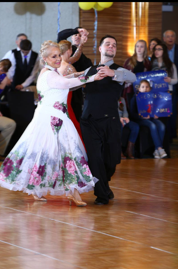
Gail Ingis & instructor Henry Skopp at Foxwoods competition. Gail got 1st place in Waltz and Foxtrot.
Dancin’ feet! Do you know the latest dance? Bet you would if you could . . . dance. “Tom,” I said, “For my birthday, come on, dance with me.”
Now that we got ourselves onto the dance floor, I began to wonder about the history of ballroom dancing. Dance history is difficult to access because dance does not often leave behind clearly identifiable physical artifacts that last over millennia, such as stone tools, hunting implements or cave paintings. It is not possible to identify with exact precision when dance became part of human culture. I suspect millenniums. We do know though, early dance, like 18th century sequence ballroom dancing in Jane Austen’s world, was used as a method of healing and expression. That has not changed.
Dancing with the Stars: https://youtu.be/nTWNrvnm2J8?t=20
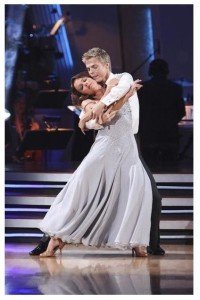
Dancing with the Stars, Jennifer Grey & Derek Hough
Modern ballroom dance has its roots early in the 20th century, when several different things happened during and after World War I. The first was a movement away from the sequence dances toward dances where the couples moved independently. This was foreshadowed by the waltz which had already made this transition. The second was a wave of popular music that led to a burst of invented dances. The third event was a concerted effort to transform some of the dance crazes into dances which could be taught to a wider dance public in the US and Europe.
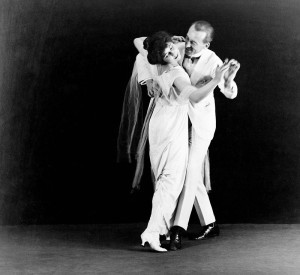
Vernon & Irene Castel, early ballroom dance pioneers, 1910-18
Here Vernon and Irene Castle were important, and so was a generation of English dancers in the 1920s. These professionals analyzed, codified, published and taught a number of standard dances. It was essential, if popular dance was to flourish, for dancers to have some basic movements they could confidently perform with any partner they might meet. Here the Arthur Murray organization in America, and the dance societies in England, such as the Imperial Society of Teachers of Dancing, were influential.
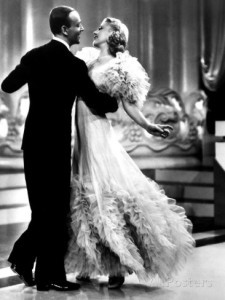
Fred Astaire & Ginger Rogers
Later, in the 1930s, the on-screen dance pairing of Fred Astaire and Ginger Rogers influenced all forms of dance in the USA and elsewhere. Much of their work portrayed social dancing, although the performances were highly choreographed, meticulously staged and rehearsed.
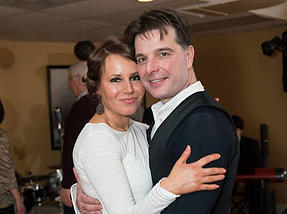
Henry Skopp and Monika Barska, our instructors at Southport, Fairfield, CT Fred Astaire Studios
Ballroom dance may refer to almost any type of partner dancing as recreation. However, with the emergence of dancesport in modern times, the term has become narrower in scope, and traditionally refers to the International Standard and International Latin style dances. The styles, while differing in technique, rhythm and costumes, exemplify core elements of ballroom dancing such as control and cohesiveness. There are variations that are popular: American Smooth and American Rhythm which combine elements of both traditional Latin and Ballroom dances.
Competitive dancing
Talented children dancing cha-cha-cha at a junior Latin dance competition in the Czech Republic. You should see kids like this dance live, they are terrific. Studying dance is hard work. For these competitions, it takes hours and hours and hours of lessons and practice.
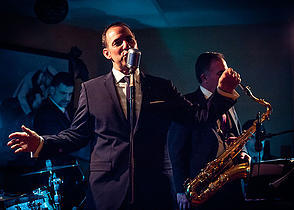
Dance to the music
Competitions, available for the ambitious, are sometimes referred to as Dancesport, range from world championships, regulated by the World Dance Council (WDC), to less advanced dancers at various proficiency levels. Most competitions are divided into professional and amateur, though in the USA pro-am competitions typically accompany professional competitions.The International Olympic Committee now recognizes competitive ballroom dance. It has recognized another body, the World DanceSport Federation (WDSF), as the sole representative body for dancesport in the Olympic Games. However, it seems doubtful that dance will be included in the Olympic Games, especially in light of efforts to reduce the number of participating sports.
Swing . . . one of my favorites. I also love the Waltz, it’s dreamy. We dance three days a week, private, practice and group. An amazing exercise. The benefits are astounding.
Personalized too! Birthday surprise for me at our ballroom dance party! And Tom next to me did it, went from never danced in life, to dancing with his wife. That’s me.
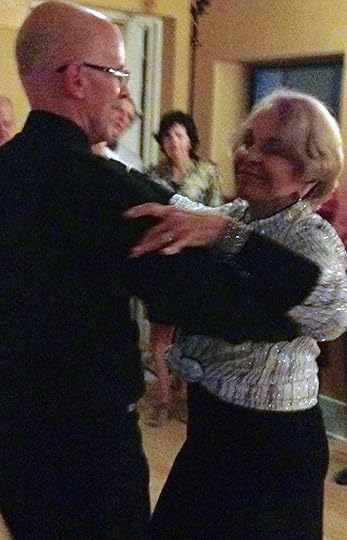
Tom and Gail
What’s your favorite dance?
Thanks to Wikipedia!
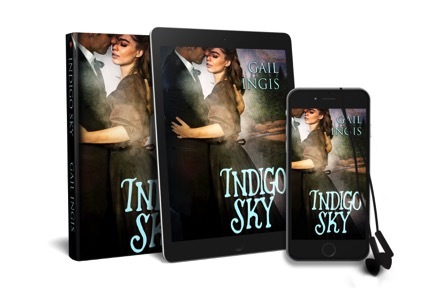
Print book, eBook, Audiobook.
April 19, 2017
How to Hold Your Reader on the Ride with Dynamic Pacing

Thunderbolt
We are passing on this AutoCrit excellent blog, with permission from Jocelyn, for your perusal.
Ever watched a movie that was so packed full of non-stop action it left you feeling breathless? Exhilarated, maybe… but disconnected from the characters – unable to learn much about them amidst the constant stream of explosions, car chases and death-defying peril?
Or have you ever read a story where the author droned on for so long about their characters’ thoughts, feelings, family history, and childhood until you thought please… please just let something – anything – happen?
If so, you’ve more than likely encountered a problem with pacing.
Pacing refers to the momentum of a story. There are times we want the reader frantically turning pages because there’s so much high-energy action, and there are times when we want to slow down the story – to let the reader sink into the prose like they would a warm, soothing bath.
Keeping the brain engaged requires a consistent mixture of these – like a rollercoaster ride. Take the reader slowly up to the top and then slam them down the other side, through blinding loops and breakneck corners… and then slow them back down again in preparation for the next dose of action.
A good story has a mix of fast-paced and slow-paced sections. This variety helps us generate tension, build anticipation, develop our characters, insert descriptions, drive the plot forward, and — above all – maintain our reader’s interest.
Strategies for keeping your ride in tip-top shape
Introspection and back-story are better “sprinkled” than “dumped”
Be careful if you have too many paragraphs or pages of long-winded back-story. Sizeable chunks of this can kill your pacing stone dead – something the AutoCrit Pacing Report can highlight for you.
Back-story should be woven in throughout your manuscript, organically drip-fed amidst the action rather than taking up extended chunks of space in the book.
Match your pacing to your story
Action scenes should have few (if any) slow-paced paragraphs. Sure, you might want to occasionally pause for breath to keep things from flying off the rails, but save the slow-paced sections for your more reflective scenes.
Use more dialogue in fast-paced scenes and more narrative in slower scenes
The quick-fire nature of dialogue can speed up a scene. Likewise, narrative prose can slow it down. Play with both techniques to control the momentum of your story.
Experiment with sentence lengths
Shorter sentences speed up a paragraph, while lengthy sentences slow down the momentum. Variety throughout your manuscript is key, but be careful to ensure you’re employing the right kind of sentences in the right places to keep your reader firmly under your control.
The exception to the rule
Every chapter should have a balance between fast- and slow-paced sections – with one exception: The first chapter.
The first chapter should move quickly with only the sparest bit of back-story. A line or two to give the reader context is okay; even a short paragraph here and there might be okay. But for the most part, you want to start with a bang and save the slow-paced sections for later in the manuscript.
Why? Because the first chapter is the most critical. It’s the chapter that determines whether your reader will keep reading, whether an agent will offer you a contract, and whether a publisher will consider your book for print. (No pressure, right?)
As sad as it sounds, the first chapter represents the entire book. It tells the reader about much more than the characters and situation – it shows them how you write and what they can expect in terms of storytelling.
If you bog that chapter down with exposition, description, and excessive narrative, it sends the message that the whole book will be a cumbersome read. So keep it moving and save the slow-paced sections for chapter two and beyond.
Pacing is one of the most important elements in a story. Keep it dynamic, and balance fast- and slow-paced sections to keep your readers turning those pages.
So go on – give a few of your chapters a careful look over and see if there are any points where your pacing is running away from you or slowing you to a crawl.
If you’re unsure, why not become an AutoCrit member for just $29.97/mo and give the Pacing & Momentum reports a try – alongside the many others, of course…
All of which are uniquely designed to quickly and easily ensure your manuscript stacks up against proven published works of fiction across multiple genres – so your next draft gains a better chance of getting snapped up by publishers than any other editing tool on the market can give it.

Indigo Sky, historical romance! AmazonKindle http://amzn.to/2nWqbcq. Author page: http://amzn.to/1K4GVQA

 Samanthya Wyatt Author
Samanthya Wyatt Author
